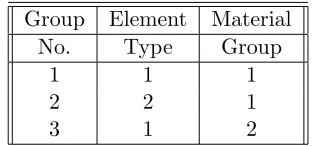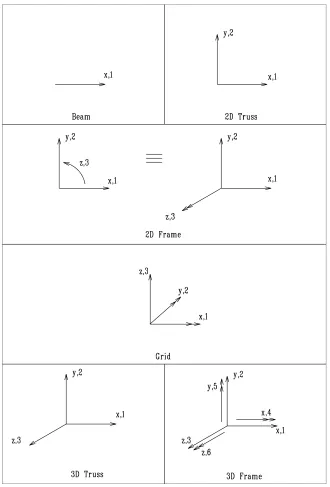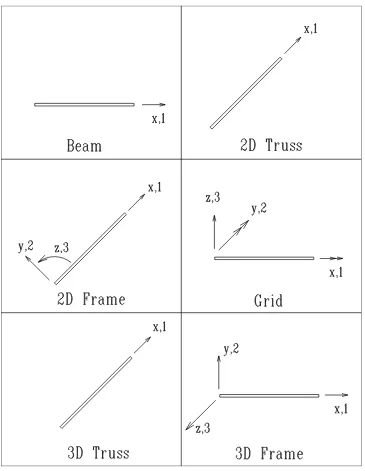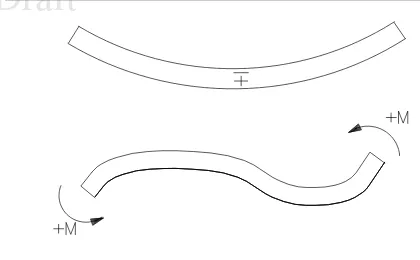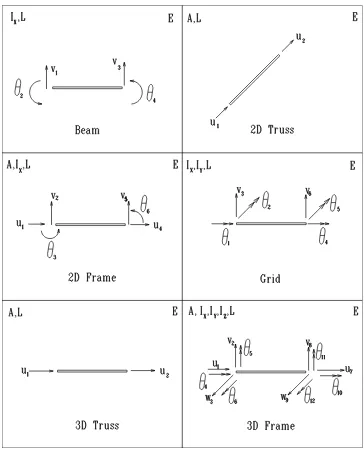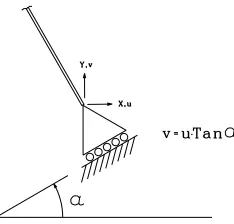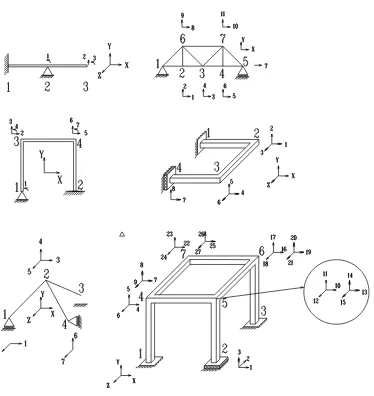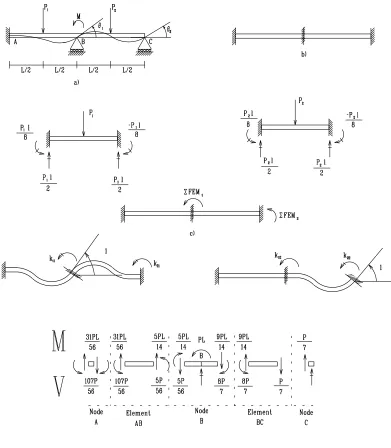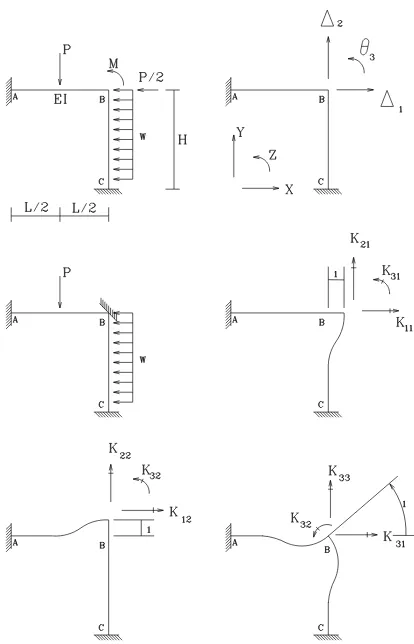Draft
DRAFT
Lecture Notes in:
MATRIX STRUCTURAL ANALYSIS
with an
Introduction to Finite Elements
CVEN4525/5525
c
VICTOR E. SAOUMA,
Fall 1999
Draft
Contents
1 INTRODUCTION
1–1
1.1
Why Matrix Structural Analysis? . . . 1–1
1.2
Overview of Structural Analysis . . . 1–2
1.3 Structural Idealization . . . 1–4
1.3 .1
Structural Discretization . . . 1–5
1.3 .2
Coordinate Systems . . . 1–6
1.3 .3
Sign Convention . . . 1–6
1.4
Degrees of Freedom . . . 1–9
1.5
Course Organization . . . 1–11
I
Matrix Structural Analysis of Framed Structures
1–15
2 ELEMENT STIFFNESS MATRIX
2–1
3 .1
Introduction . . . 3 –1
3 .2
The Stiffness Method . . . 3 –2
3 .3
Examples . . . 3 –4
E 3 -1 Beam . . . 3 –4
E 3 -2 Frame . . . 3 –6
E 3 -3
Grid . . . 3 –9
3 .4
Observations . . . 3 –13
4 TRANSFORMATION MATRICES
4–1
4.1
Derivations . . . 4–1
4.1.1
[
k
e] [
K
e] Relation
. . . 4–1
4.1.2
Direction Cosines . . . 4–2
4.2
Transformation Matrices For Framework Elements . . . 4–6
4.2.1
2 D cases . . . 4–6
4.2.1.1
2D Frame, and Grid Element . . . 4–6
4.2.1.2
2D Truss . . . 4–8
4.2.2
3 D Frame . . . 4–8
4.2.2.1
Simple 3 D Case . . . 4–9
4.2.2.2
General Case . . . 4–12
4.2.3 3
D Truss . . . 4–15
5 STIFFNESS METHOD; Part II
5–1
Draft
CONTENTS
0–3
5.8.1.1
Input Variable Descriptions . . . 5–3 7
5.8.1.2
Sample Input Data File . . . 5–3 8
5.8.1.3 Program Implementation . . . 5–40
5.8.2
Program Listing . . . 5–40
5.8.2.1
Main Program . . . 5–40
5.8.2.2
Assembly of
ID
Matrix . . . 5–43
5.8.2.3 Element Nodal Coordinates . . . 5–44
5.8.2.4
Element Lengths . . . 5–45
5.8.2.5
Element Stiffness Matrices . . . 5–45
5.8.2.6
Transformation Matrices . . . 5–46
5.8.2.7
Assembly of the Augmented Stiffness Matrix . . . 5–47
5.8.2.8
Print General Information . . . 5–48
5.8.2.9
Print Load . . . 5–49
5.8.2.10 Load Vector . . . 5–50
5.8.2.11 Nodal Displacements . . . 5–52
5.8.2.12 Reactions . . . 5–53
5.8.2.13 Internal Forces . . . 5–54
5.8.2.14 Sample Output File . . . 5–55
6 EQUATIONS OFSTATICS and KINEMATICS
6–1
6.1
Statics Matrix [
B
] . . . 6–1
E 6-1 Statically Determinate Truss Statics Matrix . . . 6–2
E 6-2 Beam Statics Matrix . . . 6–4
E 6-3 Statically Indeterminate Truss Statics Matrix . . . 6–6
6.1.1
Identification of Redundant Forces . . . 6–9
E 6-4 Selection of Redundant Forces
. . . 6–9
6.1.2
Kinematic Instability . . . 6–12
6.2
Kinematics Matrix [
A
] . . . 6–12
E 6-5 Kinematics Matrix of a Truss . . . 6–14
6.3 Statics-Kinematics Matrix Relationship . . . 6–15
6.3 .1
Statically Determinate . . . 6–15
6.3 .2
Statically Indeterminate . . . 6–16
6.4
Kinematic Relations through Inverse of Statics Matrix . . . 6–16
6.5
Congruent Transformation Approach to [
K
] . . . 6–17
E 6-6 Congruent Transformation . . . 6–18
E 6-7 Congruent Transformation of a Frame . . . 6–20
7 FLEXIBILITY METHOD
7–1
7.3Stiffness Flexibility Relations . . . 7–5
7.3.1
From Stiffness to Flexibility . . . 7–6
E 7-2 Flexibility Matrix
. . . 7–6
7.3.2
From Flexibility to Stiffness . . . 7–7
E 7-3Flexibility to Stiffness . . . 7–8
7.4
Stiffness Matrix of a Curved Element . . . 7–9
7.5
Duality between the Flexibility and the Stiffness Methods . . . 7–11
II
Introduction to Finite Elements
7–13
8 REVIEW OFELASTICITY
8–1
8.1
Stress . . . 8–1
8.1.1
Stress Traction Relation . . . 8–2
8.2
Strain . . . 8–3
8.3Fundamental Relations in Elasticity . . . 8–4
8.3.1
Equation of Equilibrium . . . 8–4
8.3.2
Compatibility Equation . . . 8–5
8.4
Stress-Strain Relations in Elasticity . . . 8–6
8.5
Strain Energy Density . . . 8–7
8.6
Summary . . . 8–7
9 VARIATIONAL AND ENERGY METHODS
9–1
Draft
CONTENTS
0–5
9.2.5.1.2
Linear Elastic Systems . . . 9–17
9.2.5.2
External Complementary Virtual Work
δW
∗. . . 9–18
9.2.6
Potential Energy . . . 9–18
9.2.6.1
Potential Functions . . . 9–18
9.2.6.2
Potential of External Work . . . 9–19
9.2.6.3 Potential Energy . . . 9–19
9.3 Principle of Virtual Work and Complementary Virtual Work . . . 9–19
9.3 .1
Principle of Virtual Work . . . 9–20
9.3.1.1
†
Derivation . . . 9–20
E 9-3Tapered Cantiliver Beam, Virtual Displacement . . . 9–23
9.3 .2
Principle of Complementary Virtual Work . . . 9–25
9.3.2.1
†
Derivation . . . 9–25
E 9-4 Tapered Cantilivered Beam; Virtual Force . . . 9–27
E 9-5 Three Hinged Semi-Circular Arch . . . 9–29
E 9-6 Cantilivered Semi-Circular Bow Girder . . . 9–3 1
9.4
Potential Energy . . . 9–3 2
9.4.1
Derivation . . . 9–3 2
9.4.2
‡
Euler Equations of the Potential Energy . . . 9–3 5
9.4.3 Castigliano’s First Theorem . . . 9–3
7
E 9-7 Fixed End Beam, Variable I . . . 9–3 7
9.4.4
Rayleigh-Ritz Method . . . 9–40
E 9-8 Uniformly Loaded Simply Supported Beam; Polynomial Approximation . 9–41
E 9-9 Uniformly Loaded Simply Supported Beam; Fourrier Series . . . 9–43
E 9-10 Tapered Beam; Fourrier Series . . . 9–44
9.5
†
Complementary Potential Energy . . . 9–46
9.5.1
Derivation . . . 9–46
9.5.2
Castigliano’s Second Theorem . . . 9–46
E 9-11 Cantilivered beam . . . 9–47
9.5.2.1
Distributed Loads . . . 9–47
E 9-12 Deflection of a Uniformly loaded Beam using Castigliano’s Theorem . . . 9–48
9.6
Comparison of Alternate Approximate Solutions . . . 9–48
E 9-13 Comparison of MPE Solutions . . . 9–48
9.7
Summary . . . 9–49
10 INTERPOLATION FUNCTIONS
10–1
10.3 .1.1 Constant Strain Quadrilateral Element . . . 10–9
10.3.1.2 Solid Rectangular Trilinear Element . . . 10–11
10.3.2
C
1: Hermitian Interpolation Functions . . . 10–11
10.4 Interpretation of Shape Functions in Terms of Polynomial Series . . . 10–12
10.5 Characteristics of Shape Functions . . . 10–12
11 FINITE ELEMENT FORMULATION
11–1
11.1 Strain Displacement Relations . . . 11–1
11.1.1 Axial Members . . . 11–1
11.1.2 Flexural Members . . . 11–2
11.2 Virtual Displacement and Strains . . . 11–2
11.3 Element Stiffness Matrix Formulation . . . 11–2
11.3 .1 Stress Recovery . . . 11–4
12 SOME FINITE ELEMENTS
12–1
12.1 Introduction . . . 12–1
12.2 Truss Element . . . 12–1
12.3 Flexural Element . . . 12–2
12.4 Triangular Element . . . 12–3
12.4.1 Strain-Displacement Relations
. . . 12–3
12.4.2 Stiffness Matrix . . . 12–4
12.4.3 Internal Stresses . . . 12–4
12.4.4 Observations . . . 12–5
12.5 Quadrilateral Element . . . 12–5
13 GEOMETRIC NONLINEARITY
13–1
13 .1 Strong Form . . . 13 –1
13 .1.1 Lower Order Differential Equation . . . 13 –1
13 .1.2 Higher Order Differential Equation . . . 13 –3
13 .1.3
Slenderness Ratio . . . 13 –5
13 .2 Weak Form . . . 13 –6
13 .2.1 Strain Energy . . . 13 –6
13 .2.2 Euler Equation . . . 13 –9
13 .2.3
Discretization . . . 13 –9
13.3 Elastic Instability . . . 13 –11
Draft
CONTENTS
0–7
A REFERENCES
A–1
B REVIEW of MATRIX ALGEBRA
B–1
B.1 Definitions . . . B–1
B.2 Elementary Matrix Operations . . . B–3
B.3 Determinants . . . B–4
B.4 Singularity and Rank . . . B–5
B.5 Inversion . . . B–5
B.6 Eigenvalues and Eigenvectors . . . B–5
C SOLUTIONS OFLINEAR EQUATIONS
C–1
C.1 Introduction . . . C–1
C.2 Direct Methods . . . C–2
C.2.1 Gauss, and Gaus-Jordan Elimination . . . C–2
E C-1 Gauss Elimination . . . C–2
E C-2 Gauss-Jordan Elimination . . . C–3
C.2.1.1
Algorithm
. . . C–4
C.2.2
LU
Decomposition . . . C–4
C.2.2.1
Algorithm
. . . C–5
E C-3 Example . . . C–6
C.2.3 Cholesky’s Decomposition . . . C–7
E C-4 Cholesky’s Decomposition . . . C–8
C.2.4 Pivoting . . . C–9
C.3 Indirect Methods . . . C–9
C.3 .1 Gauss Seidel . . . C–9
C.4 Ill Conditioning . . . C–10
C.4.1 Condition Number . . . C–10
C.4.2 Pre Conditioning . . . C–10
C.4.3 Residual and Iterative Improvements . . . C–10
D TENSOR NOTATION
D–1
D.1 Engineering Notation . . . D–1
D.2 Dyadic/Vector Notation . . . D–2
D.3 Indicial/Tensorial Notation . . . D–2
E INTEGRAL THEOREMS
E–1
Draft
List of Figures
1.1
Global Coordinate System . . . 1–7
1.2
Local Coordinate Systems . . . 1–8
1.3 Sign Convention, Design and Analysis . . . 1–9
1.4
Total Degrees of Freedom for various Type of Elements
. . . 1–10
1.5
Independent Displacements . . . 1–11
1.6
Examples of Global Degrees of Freedom . . . 1–13
1.7
Organization of the Course . . . 1–14
2.1
Example for Flexibility Method . . . 2–3
2.2
Definition of Element Stiffness Coefficients . . . 2–5
2.3 Stiffness Coefficients for One Dimensional Elements . . . 2–6
2.4
Flexural Problem Formulation . . . 2–7
2.5
Torsion Rotation Relations . . . 2–9
2.6
Deformation of an Infinitesimal Element Due to Shear . . . 2–11
2.7
Effect of Flexure and Shear Deformation on Translation at One End . . . 2–13
2.8
Effect of Flexure and Shear Deformation on Rotation at One End . . . 2–14
3.1
Problem with 2 Global d.o.f.
θ
1and
θ
2. . . 3 –3
3.2
*Frame Example (correct
K
23) . . . 3 –6
3 .3
Grid Example . . . 3 –10
5.2
Flowchart for Assembling Global Stiffness Matrix . . . 5–5
5.3 Example of Bandwidth . . . 5–7
5.4
Numbering Schemes for Simple Structure . . . 5–7
5.5
Beam Element . . . 5–10
5.6
ID Values for Simple Beam . . . 5–20
5.7
Simple Frame Anlysed with the MATLAB Code . . . 5–20
5.8
Simple Frame Anlysed with the MATLAB Code . . . 5–22
5.9
Program Flowchart . . . 5–27
5.10 Program’s Tree Structure . . . 5–28
5.11 Flowchart for the Skyline Height Determination . . . 5–3 0
5.12 Flowchart for the Global Stiffness Matrix Assembly . . . 5–3 1
5.13 Flowchart for the Load Vector Assembly . . . 5–33
5.14 Flowchart for the Internal Forces . . . 5–3 4
5.15 Flowchart for the Reactions . . . 5–3 5
5.16 Structure Plotted with CASAP . . . 5–56
6.1
Example of [
B
] Matrix for a Statically Determinate Truss . . . 6–3
6.2
Example of [
B
] Matrix for a Statically Determinate Beam . . . 6–5
6.3Example of [
B
] Matrix for a Statically Indeterminate Truss . . . 6–7
6.4
*Examples of Kinematic Instability . . . 6–13
6.5
Example 1, Congruent Transfer . . . 6–19
6.6
Example 2 . . . 6–21
7.1
Stable and Statically Determinate Element . . . 7–6
7.2
Example 1, [
k
]
→
[
d
] . . . 7–7
8.1
Stress Components on an Infinitesimal Element . . . 8–1
8.2
Stress Traction Relations
. . . 8–2
8.3Equilibrium of Stresses, Cartesian Coordinates . . . 8–4
8.4
Fundamental Equations in Solid Mechanics . . . 8–8
Draft
LIST OFFIGURES
0–3
9.12 Variable Cross Section Fixed Beam . . . 9–3 8
9.13Uniformly Loaded Simply Supported Beam Analysed by the Rayleigh-Ritz Method9–42
9.14 Example xx: External Virtual Work . . . 9–44
9.15 Summary of Variational Methods . . . 9–50
9.16 Duality of Variational Principles . . . 9–51
10.1 Axial Finite Element . . . 10–2
10.2 Flexural Finite Element . . . 10–4
10.3 Shape Functions for Flexure of Uniform Beam Element. . . 10–6
10.4 *Constant Strain Triangle Element . . . 10–7
10.5 Constant Strain Quadrilateral Element . . . 10–10
10.6 Solid Trilinear Rectangular Element . . . 10–11
13 .1 Euler Column . . . 13 –1
13.2 Simply Supported Beam Column; Differential Segment; Effect of Axial Force P . 13–4
13.3 Solution of the Tanscendental Equation for the Buckling Load of a Fixed-Hinged
Draft
List of Tables
1.1
Example of Nodal Definition
. . . 1–5
1.2
Example of Element Definition . . . 1–5
1.3 Example of Group Number . . . 1–6
1.4
Degrees of Freedom of Different Structure Types Systems . . . 1–12
2.1
Examples of Influence Coefficients . . . 2–2
6.1
Internal Element Force Definition for the Statics Matrix . . . 6–2
6.2
Conditions for Static Determinacy, and Kinematic Instability . . . 6–13
9.1
Essential and Natural Boundary Conditions . . . 9–5
9.2
Possible Combinations of Real and Hypothetical Formulations . . . 9–20
9.3 Comparison of 2 Alternative Approximate Solutions . . . 9–49
9.4
Summary of Variational Terms Associated with One Dimensional Elements . . . 9–52
Draft
LIST OFTABLES
0–3
NOTATION
a
Vector of coefficcients in assumed displacement field
A
Area
A
Kinematics Matrix
b
Body force vector
B
Statics Matrix, relating external nodal forces to internal forces
[
B
′]
Statics Matrix relating nodal load to internal forces
p
= [
B
′]
P
[
B
]
Matrix relating assumed displacement fields parameters to joint displacements
C
Cosine
[
C
1
|
C
2]
Matrices derived from the statics matrix
{
d
}
Element flexibility matrix (lc)
{
d
c}
[
D
]
Structure flexibility matrix (GC)
E
Elastic Modulus
[
E
]
Matrix of elastic constants (Constitutive Matrix)
{
F
}
Unknown element forces and unknown support reactions
{
F
0}
Nonredundant element forces (lc)
{
Fx
}
Redundant element forces (lc)
{
F
e}
Element forces (lc)
FEA
Fixed end actions of a restrained member
G
Shear modulus
I
Moment of inertia
[
L
]
Matrix relating the assumed displacement field parameters
to joint displacements
[
I
]
Idendity matrix
[
ID
]
Matrix relating nodal dof to structure dof
J
St Venant’s torsional constant
[
k
]
Element stiffness matrix (lc)
[
p
]
Matrix of coefficients of a polynomial series
[
k
g]
Geometric element stiffness matrix (lc)
[
k
r]
Rotational stiffness matrix ( [
d
] inverse )
[
K
]
Structure stiffness matrix (GC)
[
K
g]
Structure’s geometric stiffness matrix (GC)
L
Length
L
Linear differential operator relating displacement to strains
l
ijDirection cosine of rotated axis i with respect to original axis j
{
LM
}
structure dof of nodes connected to a given element
{
N
}
Shape functions
{
p
}
Element nodal forces = F (lc)
t
Traction vector
t
Specified tractions along Γ
tu
Displacement vector
˜
u
Neighbour function to
u
(
x
)
u
(
x
)
Specified displacements along Γ
uu, v, w
Translational displacements along the x, y, and z directions
U
Strain energy
U
∗Complementary strain energy
x, y
loacal coordinate system (lc)
X, Y
Global coordinate system (GC)
W
Work
α
Coefficient of thermal expansion
[
Γ
]
Transformation matrix
{
δ
}
Element nodal displacements (lc)
{
∆
}
Nodal displacements in a continuous system
{
∆
}
Structure nodal displacements (GC)
ǫ
Strain vector
ǫ
0Initial strain vector
{
Υ
}
Element relative displacement (lc)
{
Υ
0}
Nonredundant element relative displacement (lc)
{
Υ
x}
Redundant element relative displacement (lc)
θ
rotational displacement with respect to z direction (for 2D structures)
δ
Variational operator
δM
Virtual moment
δP
Virtual force
δθ
Virtual rotation
δu
Virtual displacement
δφ
Virtual curvature
δU
Virtual internal strain energy
δW
Virtual external work
δ
ǫ
Virtual strain vector
δ
σ
Virtual stress vector
Γ
Surface
Γ
tSurface subjected to surface tractions
Γ
uSurface associated with known displacements
σ
Stress vector
σ
0Initial stress vector
Ω
Volume of body
Draft
Chapter 1
INTRODUCTION
1.1
Why Matrix Structural Analysis?
1
In most Civil engineering curriculum, students are required to take courses in: Statics,
Strength of Materials, Basic Structural Analysis. This last course is a fundamental one which
introduces basic structural analysis (determination of reactions, deflections, and internal forces)
of both statically determinate and indeterminate structures.
2
Also Energy methods are introduced, and most if not all examples are two dimensional. Since
the emphasis is on hand solution, very seldom are three dimensional structures analyzed. The
methods covered, for the most part lend themselves for “back of the envelope” solutions and
not necessarily for computer implementation.
3
Those students who want to pursue a specialization in structural engineering/mechanics, do
take more advanced courses such as Matrix Structural Analysis and/or Finite Element Analysis.
4
Matrix Structural Analysis, or Advanced Structural Analysis, or Introduction to Structural
Engineering Finite Element, builds on the introductory analysis course to focus on those
meth-ods which lend themselves to computer implementation. In doing so, we will place equal
emphasis on both two and three dimensional structures, and develop a thorough understanding
of computer aided analysis of structures.
5
This is essential, as in practice most, if not all, structural analysis are done by the computer
and it is imperative that as structural engineers you understand what is inside those “black
boxes”, develop enough self assurance to be capable of opening them and modify them to
perform certain specific tasks, and most importantly to understand their limitations.
7
Whereas two and three dimensional continuum are essential in civil engineering to model
structures such as dams, shells, and foundation, the majority of Civil engineering structures
are constituted by “rod” one-dimensional elements such as beams, girders, or columns. For
those elements, “displacements” and internal “forces” are somehow more complex than those
encountered in continuum finite elements.
8
Hence, contrarily to continuum finite element where displacement is mostly synonymous with
translation, in one dimensional elements, and depending on the type of structure, generalized
displacements may include translation, and/or flexural and/or torsional rotation. Similarly,
“internal forces” are not stresses, but rather axial and shear forces, and/or flexural or torsional
moments. Those concepts are far more relevant in the analysis/design of most civil engineering
structures.
9
Hence, Matrix Structural Analysis, is truly a bridge course between introductory analysis
and finite element courses. The element stiffness matrix [
k
] will first be derived using methods
introduced in basic structural analysis, and later using energy based concepts. This later
approach is the one exclusively used in the finite element method.
10
An important component of this course is computer programing. Once the theory and the
algorithms are thoroughly explained, you will be expected to program them in either Fortran
(preferably 90) or C (sorry, but no Basic) on the computer of your choice. The program
(typically about 3,500 lines) will perform the analysis of 2 and 3 dimensional truss and frame
structures, and many students have subsequently used it in their professional activities.
11
There will be one computer assignment in which you will be expected to perform
sim-ple symbolic manipulations using
Mathematica
. For those of you unfamiliar with the
Bechtel
Laboratory
, there will be a special session to introduce you to the operation of Unix on Sun
workstations.
1.2
Overview of Structural Analysis
12
To put things into perspective, it may be helpful to consider classes of Structural Analysis
which are distinguished by:
1. Excitation model
(a) Static
(b) Dynamic
2. Structure model
(a) Global geometry
Draft
1.2 Overview of Structural Analysis
1–3
•
large deformation (
ε
x=
dudx+
12dv dx
2
, P-∆ effects), chapter 13
(b) Structural elements element types:
•
1D framework (truss, beam, columns)
•
2D finite element (plane stress, plane strain, axisymmetric, plate or shell
ele-ments), chapter 12
•
3D finite element (solid elements)
(c) Material Properties:
•
Linear
•
Nonlinear
(d) Sectional properties:
•
Constant
•
Variable
(e) Structural connections:
•
Rigid
•
Semi-flexible (linear and non-linear)
(f) Structural supports:
•
Rigid
•
Elastic
3. Type of solution:
(a) Continuum, analytical, Partial Differential Equation
(b) Discrete, numerical, Finite ELement, Finite Difference, Boundary Element
13
Structural design must satisfy:
1. Strength (
σ < σ
f)
2. Stiffness (“small” deformations)
3. Stability (buckling, cracking)
14
Structural analysis must satisfy
1. Statics (equilibrium)
15
Prior to analysis, a structure must be idealized for a suitable mathematical representation.
Since it is practically impossible (and most often unnecessary) to model every single detail,
assumptions must be made. Hence, structural idealization is as much an art as a science.
Some
of the questions confronting the analyst include:
1. Two dimensional versus three dimensional; Should we model a single bay of a building,
or the entire structure?
2. Frame or truss, can we neglect flexural stiffness?
3. Rigid or semi-rigid connections (most important in steel structures)
4. Rigid supports or elastic foundations (are the foundations over solid rock, or over clay
which may consolidate over time)
5. Include or not secondary members (such as diagonal braces in a three dimensional
anal-ysis).
6. Include or not axial deformation (can we neglect the axial stiffness of a beam in a
build-ing?)
7. Cross sectional properties (what is the moment of inertia of a reinforced concrete beam?)
8. Neglect or not haunches (those are usually present in zones of high negative moments)
9. Linear or nonlinear analysis (linear analysis can not predict the peak or failure load, and
will underestimate the deformations).
10. Small or large deformations (In the analysis of a high rise building subjected to wind
load, the moments should be amplified by the product of the axial load times the lateral
deformation,
P
−
∆ effects).
11. Time dependent effects (such as creep, which is extremely important in prestressed
con-crete, or cable stayed concrete bridges).
12. Partial collapse or local yielding (would the failure of a single element trigger the failure
of the entire structure?).
13. Load static or dynamic (when should a dynamic analysis be performed?).
14. Wind load (the lateral drift of a high rise building subjected to wind load, is often the
major limitation to higher structures).
15. Thermal load (can induce large displacements, specially when a thermal gradient is
present.).
Draft
1.3 Structural Idealization
1–5
1.3.1
Structural Discretization
16
Once a structure has been idealized, it must be discretized to lend itself for a mathematical
representation which will be analyzed by a computer program. This discretization should
uniquely define each node, and member.
17
The node is characterized by its nodal id (node number), coordinates, boundary conditions,
and load (this one is often defined separately), Table 1.1. Note that in this case we have two
Node No.
Coor.
B. C.
X
Y
X
Y
Z
1
0.
0.
1
1
0
2
5.
5.
0
0
0
3
20.
5.
0
0
0
4
25.
2.5
1
1
1
Table 1.1: Example of Nodal Definition
nodal coordinates, and three degrees of freedom (to be defined later) per node. Furthermore,
a 0 and a 1 indicate unknown or known displacement. Known displacements can be zero
(restrained) or non-zero (as caused by foundation settlement).
18
The element is characterized by the nodes which it connects, and its group number, Table
1.2.
Element
From
To
Group
No.
Node
Node
Number
1
1
2
1
2
3
2
2
3
3
4
2
Table 1.2: Example of Element Definition
19
Group number will then define both element type, and elastic/geometric properties. The
last one is a pointer to a separate array, Table 1.3. In this example element 1 has element code
1 (such as beam element), while element 2 has a code 2 (such as a truss element). Material
group 1 would have different elastic/geometric properties than material group 2.
No.
Type
Group
1
1
1
2
2
1
3
1
2
Table 1.3: Example of Group Number
each element), and a sign convention become apparent.
1.3.2
Coordinate Systems
22
We should differentiate between 2 coordinate systems:
Global:
to describe the structure nodal coordinates. This system can be arbitrarily selected
provided it is a Right Hand Side (RHS) one, and we will associate with it upper case axis
labels,
X, Y, Z
, Fig. 1.1 or 1,2,3(running indeces within a computer program).
Local:
system is associated with each element and is used to describe the element internal
forces. We will associate with it lower case axis labels,
x, y, z
(or 1,2,3), Fig. 1.2.
23
The
x
-axis is assumed to be along the member, and the direction is chosen such that it points
from the 1st node to the 2nd node, Fig. 1.2.
24
Two dimensional structures will be defined in the X-Y plane.
1.3.3
Sign Convention
25
The sign convention in structural analysis is completely different than the one previously
adopted in structural analysis/design, Fig. 1.3(where we focused mostly on flexure and defined
a positive moment as one causing “tension below”. This would be awkward to program!).
26
In matrix structural analysis the sign convention adopted is consistent with the prevailing
coordinate system. Hence, we define a positive moment as one which is counter-clockwise, Fig.
1.3
27
Fig. 1.4 illustrates the sign convention associated with each type of element.
Draft
1.3 Structural Idealization
1–7
Draft
1.4 Degrees of Freedom
1–9
Figure 1.3: Sign Convention, Design and Analysis
1.4Degrees of Freedom
29
A degree of freedom (d.o.f.) is an independent generalized nodal displacement of a node.
30The displacements must be linearly independent and thus not related to each other. For
example, a roller support on an inclined plane would have three displacements (rotation
θ
, and
two translations
u
and
v
), however since the two displacements are kinematically constrained,
we only have two independent displacements, Fig. 1.5.
31
We note that we have been referring to
generalized
displacements, because we want this term
to include translations as well as rotations. Depending on the type of structure, there may
be none, one or more than one such displacement. It is unfortunate that in most introductory
courses in structural analysis, too much emphasis has been placed on two dimensional structures,
and not enough on either three dimensional ones, or two dimensional ones with torsion.
32
In most cases, there is the same number of d.o.f in local coordinates as in the global coordinate
system. One notable exception is the truss element. In local coordinate we can only have one
axial deformation, whereas in global coordinates there are two or three translations in 2D and
3D respectively for each node.
Draft
1.5 Course Organization
1–11
Figure 1.5: Independent Displacements
34
This table shows the degree of freedoms and the corresponding generalized forces.
35
We should distinguish between local and global d.o.f.’s. The numbering scheme follows the
following simple rules:
Local:
d.o.f. for a given element: Start with the first node, number the local d.o.f. in the same
order as the subscripts of the relevant local coordinate system, and repeat for the second
node.
Global:
d.o.f. for the entire structure: Starting with the 1st node, number all the unrestrained
global d.o.f.’s, and then move to the next one until all global d.o.f have been numbered,
Fig. 1.6.
Type
Node 1
Node 2
[
k
]
[
K
]
(Local)
(Global)
1 Dimensional
{
p
}
F
y1,
M
z2F
y3,
M
z4Beam
4
×
4
4
×
4
{
δ
}
v
1,
θ
2v
3,
θ
42 Dimensional
{
p
}
F
x1F
x2Truss
2
×
2
4
×
4
{
δ
}
u
1u
2{
p
}
F
x1,
F
y2,
M
z3F
x4,
F
y5,
M
z6Frame
6
×
6
6
×
6
{
δ
}
u
1,
v
2,
θ
3u
4,
v
5,
θ
6{
p
}
T
x1,
F
y2,
M
z3T
x4,
F
y5,
M
z6Grid
6
×
6
6
×
6
{
δ
}
θ
1,
v
2,
θ
3θ
4,
v
5,
θ
63Dimensional
{
p
}
F
x1,
F
x2Truss
2
×
2
6
×
6
{
δ
}
u
1,
u
2{
p
}
F
x1,
F
y2,
F
y3,
F
x7,
F
y8,
F
y9,
T
x4M
y5,
M
z6T
x10M
y11,
M
z12Frame
12
×
12
12
×
12
{
δ
}
u
1,
v
2,
w
3,
u
7,
v
8,
w
9,
θ
4,
θ
5θ
6θ
10,
θ
11θ
12Draft
1.5 Course Organization
1–13
Draft
Part I
Draft
Chapter 2
ELEMENT STIFFNESS MATRIX
2.1
Introduction
1
In this chapter, we shall derive the element stiffness matrix [
k
] of various one dimensional
elements. Only after this important step is well understood, we could expand the theory and
introduce the structure stiffness matrix [
K
] in its global coordinate system.
2
As will be seen later, there are two fundamentally different approaches to derive the stiffness
matrix of one dimensional element. The first one, which will be used in this chapter, is based on
classical methods of structural analysis (such as moment area or virtual force method). Thus,
in deriving the element stiffness matrix, we will be reviewing concepts earlier seen.
3
The other approach, based on energy consideration through the use of assumed shape
func-tions, will be examined in chapter 11. This second approach, exclusively used in the finite
element method, will also be extended to two and three dimensional continuum elements.
2.2
Influence Coefficients
4
In structural analysis an influence coefficient
C
ijcan be defined as the effect on d.o.f.
i
due to
a unit action at d.o.f.
j
for an individual element or a whole structure. Examples of Influence
Coefficients are shown in Table 2.1.
Influence Line
Load
Shear
Influence Line
Load
Moment
Influence Line
Load
Deflection
Flexibility Coefficient
Load
Displacement
Stiffness Coefficient
Displacement
Load
Table 2.1: Examples of Influence Coefficients
2.3
Flexibility Matrix (Review)
6
Considering the simply supported beam shown in Fig. 2.1, and using the local coordinate
system, we have
δ
1Using the virtual work, or more specifically, the virtual force method to analyze this problem,
(more about energy methods in Chapter 9), we have:
l
z
,
δP
and ∆ are the virtual internal force, real internal displacement, virtual
external load, and real external displacement respectively. Here, both the external virtual force
and moment are usualy taken as unity.
Virtual Force
:
Draft
2.3 Flexibility Matrix (Review)
2–3
EI
1
δMd
11 ∆=
0
1
−
x
L
δM·M
dx
=
L
3
(2.4)
Similarly, we would obtain:
EId
22=
L
0
x
L
2
dx
=
L
3
(2.5)
EId
12=
L
0
1
−
x
L
x
L
dx
=
−
L
6
=
EId
21(2.6)
7
Those results can be summarized in a matrix form as:
[
d
] =
L
6
EI
z
2
−
1
−
1
2
(2.7)
8
The flexibility method will be covered in more detailed, in chapter 7.
2.4Stiffness Coefficients
9
In the flexibility method, we have applied a unit force at a time and determined all the
induced displacements in the statically determinate structure.
10
In the stiffness method, we
1. Constrain all the degrees of freedom
2. Apply a unit displacement at each d.o.f. (while restraining all others to be zero)
3. Determine the reactions associated with all the d.o.f.
{
p
}
= [
k
]
{
δ
}
(2.8)
11
Hence
k
ijwill correspond to the reaction at dof
i
due to a unit deformation (translation or
rotation) at dof
j
, Fig. 2.2.
12
The actual stiffness coefficients are shown in Fig. 2.3for truss, beam, and grid elements in
terms of elastic and geometric properties.
Draft
2.4 Stiffness Coefficients
2–5
Draft
2.5 Force-Displacement Relations
2–7
Figure 2.4: Flexural Problem Formulation
2.5
Force-Displacement Relations
2.5.1
Axial Deformations
14
From strength of materials, the force/displacement relation in axial members is
σ
=
Eǫ
Aσ
P
=
AE
L
∆
1
(2.9)
Hence, for a unit displacement, the applied force should be equal to
AEL. From statics, the force
at the other end must be equal and opposite.
2.5.2
Flexural Deformation
15
Our objective is to seek a relation for the shear and moments at each end of a beam, in terms
of known displacements and rotations at each end.
V
1=
V
1(
v
1, θ
1, v
2, θ
2)
(2.10-a)
M
1=
M
1(
v
1, θ
1, v
2, θ
2)
(2.10-b)
V
2=
V
2(
v
1, θ
1, v
2, θ
2)
(2.10-c)
M
2=
M
2(
v
1, θ
1, v
2, θ
2)
(2.10-d)
−
EIv
′=
M
1x
−
1
2
V
1x
2
+
C
1
(2.12)
−
EIv
=
1
2
M
1x
2
−
1
6
V
1x
3
+
C
1
x
+
C
2(2.13)
18
Applying the boundary conditions at
x
= 0
v
′=
θ
1v
=
v
1
⇒
C
1=
−
EIθ
1C
2=
−
EIv
1(2.14)
19
Applying the boundary conditions at
x
=
L
and combining with the expressions for
C
1and
C
2v
′=
θ
2v
=
v
2
⇒
−
EIθ
2=
M
1L
−
12V
1L
2−
EIθ
1−
EIv
2=
12M
1L
2−
61V
1L
3−
EIθ
1L
−
EIv
1(2.15)
20
Since equilibrium of forces and moments must be satisfied, we have:
V
1+
V
2= 0
M
1−
V
1L
+
M
2= 0
(2.16)
or
V
1=
(
M
1+
M
2)
L
V
2=
−
V
1(2.17)
21
Substituting
V
1into the expressions for
θ
2and
v
2in Eq. 2.15 and rearranging
M
1−
M
2=
2EILzθ
1−
2EILzθ
22
M
1−
M
2=
6EILzθ
1+
6EIL2zv
1−
6EIL2zv
2(2.18)
22
Solving those two equations, we obtain:
M
1=
2
EI
zL
(2
θ
1+
θ
2) +
6
EI
zL
2(
v
1−
v
2)
(2.19)
M
2=
2
EI
zL
(
θ
1+ 2
θ
2) +
6
EI
zL
2(
v
1−
v
2)
(2.20)
23
Finally, we can substitute those expressions in Eq. 2.17
V
1=
6
EI
zL
2(
θ
1+
θ
2) +
12
EI
zL
3(
v
1−
v
2)
(2.21)
V
2=
−
6
EI
zL
2(
θ
1+
θ
2)
−
12
EI
zDraft
2.5 Force-Displacement Relations
2–9
Figure 2.5: Torsion Rotation Relations
2.5.3
Torsional Deformations
24
From Fig. 2.2-d. Since torsional effects are seldom covered in basic structural analysis, and
students may have forgotten the derivation of the basic equations from the Strength of Material
course, we shall briefly review them.
25
Assuming a linear elastic material, and a linear strain (and thus stress) distribution along
the radius of a circular cross section subjected to torsional load, Fig. 2.5 we have:
T
=
A
ρ
c
τ
maxstress
dA
area
F orce
ρ
arm
torque
(2.23)
=
τ
maxc
A
ρ
2dA
J
(2.24)
τ
max=
T c
J
(2.25)
Note the analogy of this last equation with
σ
=
M cIz
.
26A
ρ
2
dA
is the polar moment of inertia
J
. It is also referred to as the St. Venant’s torsion
constant. For circular cross sections
J
=
A
ρ
2dA
=
c0
ρ
2(2
πρdρ
)
=
πc
4
2
=
πd
41 +
dbFor other sections,
J
is often tabulated.
27
Note that
J
corresponds to
I
xwhere
x
is the axis along the element.
28
Having developed a relation between torsion and shear stress, we now seek a relation between
torsion and torsional rotation. In Fig. 2.5-b, we consider the arc length BD
γ
maxdx
=
d
Φ
c
⇒
ddxΦ=
γmax c
γ
max=
τmaxG dΦ
dx
=
τmaxGcτ
max=
T CJ d
Φ
dx
=
T
GJ
(2.28)
29
Finally, we can rewrite this last equation as
T dx
=
Gjd
Φ and obtain:
T
=
GJ
L
Φ
(2.29)
Note the similarity between this equation and Equation 2.9.
2.5.4Shear Deformation
30
In general, shear deformations are quite small. However, for beams with low span to depth
ratio, those deformations can not be neglected.
31
Considering an infinitesimal element subjected to shear, Fig. 2.6 and for linear elastic
ma-terial, the shear strain (assuming small displacement, i.e. tan
γ
≈
γ
) is given by
tan
γ
≈
γ
=
dv
sdx
Kinematics
=
τ
G
M aterial
(2.30)
where
dvsdx
is the slope of the beam neutral axis from the horizontal while the vertical sections
remain undeformed,
G
is the shear modulus,
τ
the shear stress, and
v
sthe shear induced
displacement.
32
In a beam cross section, the shear stress is not constant. For example for rectangular sections,
it varies parabolically, and in I sections, the flange shear components can be neglected.
τ
=
V Q
Ib
(2.31)
Draft
2.5 Force-Displacement Relations
2–11
τ
τ
τ
τ
dvs
dx y
x
γ
γ
γ =
Figure 2.6: Deformation of an Infinitesimal Element Due to Shear
to be determined,
I
is the moment of inertia of the cross sectional area about the neutral axis,
and
b
is the width of the rectangular beam.
33
The preceding equation can be simplified as
τ
=
V
A
s(2.32)
where
A
sis the effective cross section for shear (which is the ratio of the cross sectional area
to the area shear factor)
34
Let us derive the expression of
A
sfor rectangular sections. The exact expression for the
shear stress is
τ
=
V Q
Ib
(2.33)
where
Q
is the moment of the area from the external fibers to
y
with respect to the neutral
axis; For a rectangular section, this yields
τ
=
V Q
Ib
(2.34-a)
=
V
Ib
h/2
y
by
′dy
′=
V
2
I
h
24
−
y
2
(2.34-b)
=
6
V
bh
3
h
24
−
4
τ
=
V QIb=
k
VAQ
=
h/2
y
by
′
dy
′=
b
2
h
24
−
y
2
k
=
2AIh42−
y
2λ bh
A
=
A
k
2
dydz
λ
= 1
.
2
(2.35)
Thus, the form factor
λ
may be taken as 1.2 for rectangular beams of ordinary proportions,
and
A
s= 1
.
2
A
For I beams,
k
can be also approximated by 1.2, provided
A
is the area of the web.
35
Combining Eq. 2.31 and 2.32 we obtain
dv
sdx
=
V
GA
s(2.36)
Assuming
V
to be constant, we integrate
v
s=
V
GA
sx
+
C
1(2.37)
36
If the displacement
v
sis zero at the opposite end of the beam, then we solve for
C
1and
obtain
v
s=
−
V
GA
s(
x
−
L
)
(2.38)
37
We define
Φ
def=
12
EI
GA
sL
2(2.39)
=
24(1 +
ν
)
A
A
sr
L
2
(2.40)
Hence for small slenderness ratio
Lrcompared to unity, we can neglect Φ.
38
Next, we shall consider the effect of shear deformations on both translations and rotations
Effect on Translation
Due to a unit vertical translation, the end shear force is obtained from
Eq. 2.21 and setting
v
1= 1 and
θ
1=
θ
2=
v
2= 0, or
V
=
12LEI3z. At
x
= 0 we have, Fig.
2.7
v
s=
GAV LsV
=
12EIz L3Φ =
GA12EIsL2
v
s= Φ
(2.41)
Draft
2.6 Putting it All Together,
[
k
]
2–13
1
β
6EI 6EI
12EI 12EI
L2
L2
L3
L3
Figure 2.7: Effect of Flexure and Shear Deformation on Translation at One End
Effect on Rotation
Considering the beam shown in Fig. 2.8, even when a rotation
θ
1is
applied, an internal shear force is induced, and this in turn is going to give rise to shear
deformations (translation) which must be accounted for. The shear force is obtained from
Eq. 2.21 and setting
θ
1= 1 and
θ
2=
v
1=
v
2= 0, or
V
=
6EIL2z. As before
v
s=
GAV LsV
=
6EIz L2Φ =
GA12EIsL2
v
s= 0
.
5Φ
L
(2.42)
in other words, the shear deformation has moved the end of the beam (which was supposed
to have zero translation) by 0
.
5Φ
L
.
2.6
Putting it All Together,
[
k
]
39
Using basic structural analysis methods we have derived various force displacement relations
for axial, flexural, torsional and shear imposed displacements. At this point, and keeping in
mind the definition of degrees of freedom, we seek to assemble the individual element stiffness
matrices [
k
]. We shall start with the simplest one, the truss element, then consider the beam,
2D frame, grid, and finally the 3D frame element.
4EI 2EI
6EI
L L
L2
L
0.5βLθ1
0.5βLθ1
θ1=1
Figure 2.8: Effect of Flexure and Shear Deformation on Rotation at One End
2.6.1
Truss Element
41
The truss element (whether in 2D or 3D) has only one degree of freedom associated with
each node. Hence, from Eq. 2.9, we have
[
k
t] =
AE
L
u
1u
2p
11
−
1
p
2−
1
1
(2.43)
2.6.2
Beam Element
42
There are two major beam theories:
Euler-Bernoulli
which is the classical formulation for beams.
Draft
2.6 Putting it All Together,
[
k
]
2–15
2.6.2.1
Euler-Bernoulli
43
Using Equations 2.19, 2.20, 2.21 and 2.22 we can determine the forces associated with each
unit displacement.
[
k
b] =
v
1θ
1v
2θ
2V
1Eq. 2.21(
v
1= 1) Eq. 2.21(
θ
1= 1)
Eq. 2.21(
v
2= 1)
Eq. 2.21(
θ
2= 1)
M
1Eq. 2.19(
v
1= 1) Eq. 2.19(
θ
1= 1)
Eq. 2.19(
v
2= 1)
Eq. 2.19(
θ
2= 1)
V
2Eq. 2.22(
v
1= 1) Eq. 2.22(
θ
1= 1)
Eq. 2.22(
v
2= 1)
Eq. 2.22(
θ
2= 1)
M
2Eq. 2.20(
v
1= 1) Eq. 2.20(
θ
1= 1)
Eq. 2.20(
v
2= 1)
Eq. 2.20(
θ
2= 1)
(2.44)
44
The stiffness matrix of the beam element (neglecting shear and axial deformation) will thus
be
[
k
b] =
v
1θ
1v
2θ
2V
1 12LEI3z 6EIL2z−
12LEI3z 6EIL2zM
1 6EIL2z 4EILz−
6EIL2z 2EILzV
2−
12LEI3z−
6LEI2z 12LEI3z−
6EIL2zM
2 6EIL2z 2EILz−
6EIL2z 4EILz (2.45)
2.6.2.2
Timoshenko Beam
45
If shear deformations are present, we need to alter the stiffness matrix given in Eq. 2.45 in
the following manner
1. Due to translation, we must divide (or normalize) the coefficients of the first and third
columns of the stiffness matrix by 1 + Φ so that the net translation at both ends is unity.
2. Due to rotation and the effect of shear deformation
(a) The forces induced at the ends due to a unit rotation at end 1 (second column)
neglecting shear deformations are
V
1=
−
V
2=
6
EI
L
2(2.46-a)
M
1=
4
EI
L
(2.46-b)
M
2=
2
EI
L
(2.46-c)
we should counteract this parasitic shear deformation by an equal and opposite
one. Hence, we apply an additional vertical displacement of
−
0
.
5Φ
L
and the forces
induced at the ends (first column) are given by
V
1=
−
V
2=
12
EI
L
31
1 + Φ
kbt 11
(
−
0
.
5Φ
L
)
vs
(2.47-a)
M
1=
M
2=
6
EI
L
21
1 + Φ
kbt 21
(
−
0
.
5Φ
L
)
vs
(2.47-b)
Note that the denominators have already been divided by 1 + Φ in
k
bt.
(d) Summing up all the forces, we have the forces induced as a result of a unit rotation
only when the effects of both bending and shear deformations are included.
V
1=
−
V
2=
6
EI
L
2Due to Unit Rotation
+
12
EI
L
31
1 + Φ
kbt 11
(
−
0
.
5Φ
L
)
vs
Due to Parasitic Shear
(2.48-a)
=
−
6
EI
L
21
1 + Φ
(2.48-b)
M
1=
4
EI
L
Due to Unit Rotation
+
6
EI
L
21
1 + Φ
kbt 21
(
−
0
.
5Φ
L
)
vs
Due to Parasitic Shear
(2.48-c)
=
4 + Φ
1 + Φ
EI
L
(2.48-d)
M
2=
2
EI
L
Due to Unit Rotation
+
6
EI
L
21
1 + Φ
kbt 21
(
−
0
.
5Φ
L
)
vs
Due to Parasitic Shear
(2.48-e)
=
2
−
Φ
1 + Φ
EI
Draft
2.6 Putting it All Together,
[
k
]
2–17
46Thus, the element stiffness matrix given in Eq. 2.45 becomes
[
k
bV] =
2.6.3
2D Frame Element
47
The stiffness matrix of the two dimensional frame element is composed of terms from the
truss and beam elements where
k
band
k
trefer to the beam and truss element stiffness matrices
respectively.
Thus, we have:
[
k
2df r] =
49
The stiffness matrix of the grid element is very analogous to the one of the 2D frame element,
except that the axial component is replaced by the torsional one. Hence, the stiffness matrix is
[
k
g] =
Upon substitution, the grid element stiffness matrix is given by
[
k
g] =
50
Note that if shear deformations must be accounted for, the entries corresponding to shear
and flexure must be modified in accordance with Eq. 2.49
2.6.5
3D Frame Element
Draft
2.7 Remarks on Element Stiffness Matrices
2–19
51Note that if shear deformations must be accounted for, the entries corresponding to shear
and flexure must be modified in accordance with Eq. 2.49
2.7
Remarks on Element Stiffness Matrices
Singularity:
All the derived stiffness matrices are singular, that is there is at least one row and
one column which is a linear combination of others. For example in the beam element,
row 4 =
−
row 1; and L times row 2 is equal to the sum of row 3and 6. This singularity
(not present in the flexibility matrix) is caused by the linear relations introduced by the
equilibrium equations which are embedded in the formulation.
Symmetry:
All matrices are symmetric due to Maxwell-Betti’s reciprocal theorem, and the
stiffness flexibility relation.
Draft
Chapter 3
STIFFNESS METHOD; Part I:
ORTHOGONAL STRUCTURES
3.1
Introduction
1
In the previous chapter we have first derived displacement force relations for different types
of rod elements, and then used those relations to define element stiffness matrices in local
coordinates.
2
In this chapter, we seek to perform similar operations, but for an orthogonal structure in
global coordinates.
3
In the previous chapter our starting point was basic displacement-force relations resulting in
element stiffness matrices [
k
].
4
In this chapter, our starting point are those same element stiffness matrices [
k
], and our
objective is to determine the structure stiffness matrix [
K
], which when inverted, would yield
the nodal displacements.
5
The element stiffness matrices were derived for fully restrained elements.
6
This chapter will be restricted to orthogonal structures, and generalization will be discussed
later.
The stiffness matrices will be restricted to the unrestrained degrees of freedom.
8
As a “vehicle” for the introduction to the stiffness method let us consider the problem in Fig
3.1-a, and recognize that there are only two unknown displacements, or more precisely, two
global d.o.f:
θ
1and
θ
2.
9
If we were to analyse this problem by the force (or flexibility) method, then
1. We make the structure statically determinate by removing
arbitrarily
two reactions (as
long as the structure remains stable), and the beam is now statically determinate.
2. Assuming that we remove the two roller supports, then we determine the corresponding
deflections due to the actual laod (∆
Band ∆
C).
3. Apply a unit load at point
B
, and then
C
, and compute the deflections
f
ijat note
i
due
to a unit force at node
j
.
4. Write the compatibility of displacement equation
f
BBf
BCf
CBf
CCR
BR
C−
∆
1∆
2
=
0
0
(3.1)
5. Invert the matrix, and solve for the reactions
10
We will analyze this simple problem by the stiffness method.
1. The first step consists in making it kinematically determinate (as opposed to statically
determinate in the flexibility method). Kinematically determinate in this case simply
means restraining all the d.o.f. and thus prevent joint rotation, Fig 3.1-b.
2. We then determine the fixed end actions caused by the element load, and sum them for
each d.o.f., Fig 3.1-c: ΣFEM
1and ΣFEM
2.
3. In the third step, we will apply a unit displacement (rotation in this case) at each degree
of freedom at a time, and in each case we shall determine the reaction forces,
K
11,
K
21,
and
K
12,
K
22respectively. Note that we use [
K
], rather than
k
since those are forces
in the global coordinate system, Fig 3.1-d. Again note that we are focusing only on the
reaction forces corresponding to a global degree of freedom. Hence, we are not attempting
to determine the reaction at node A.
4. Finally, we write the equation of equilibrium at each node:
M
1M
2
=
ΣFEM
1ΣFEM
2
+
K
11K
12K
21K
22θ
1θ
2
